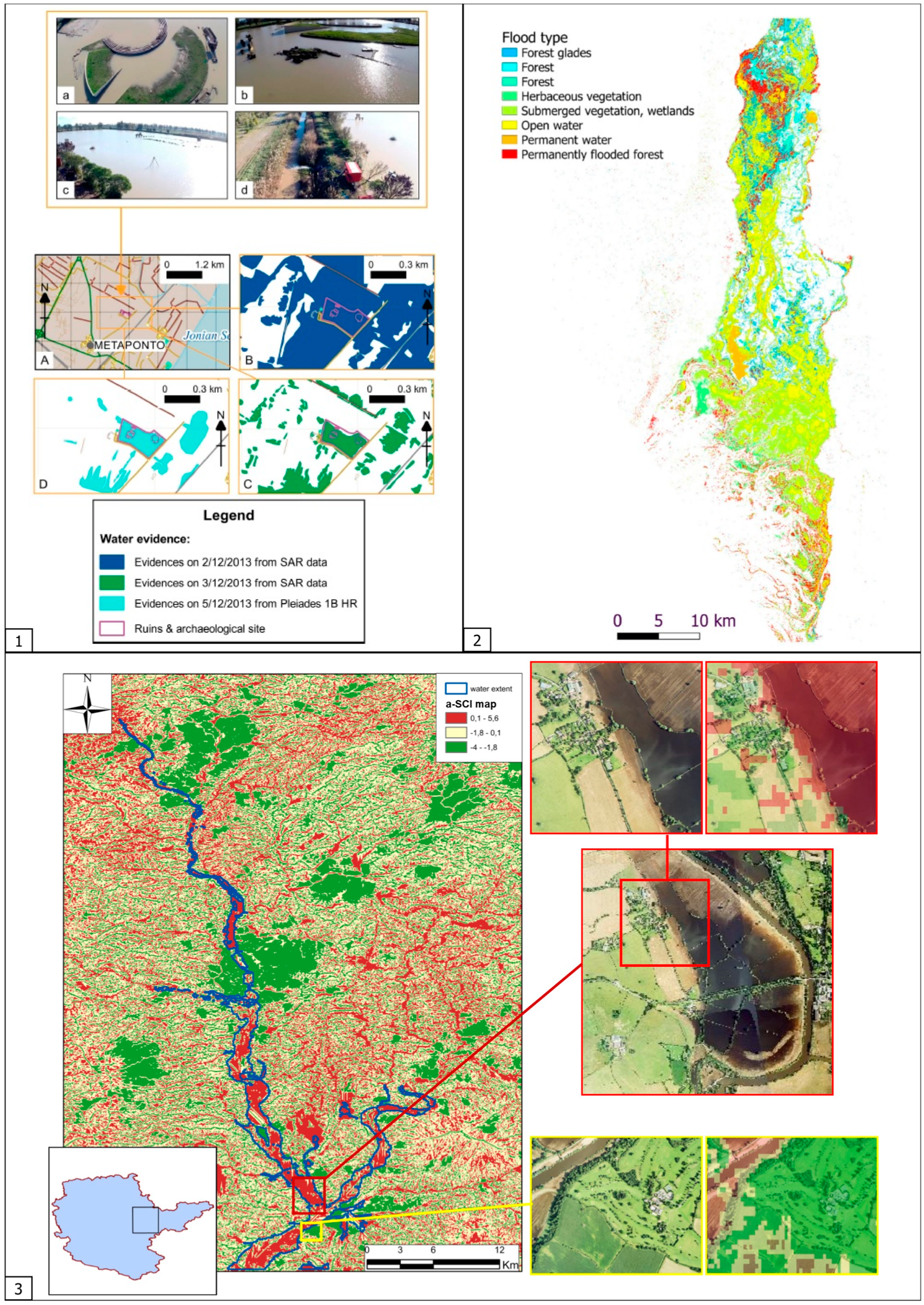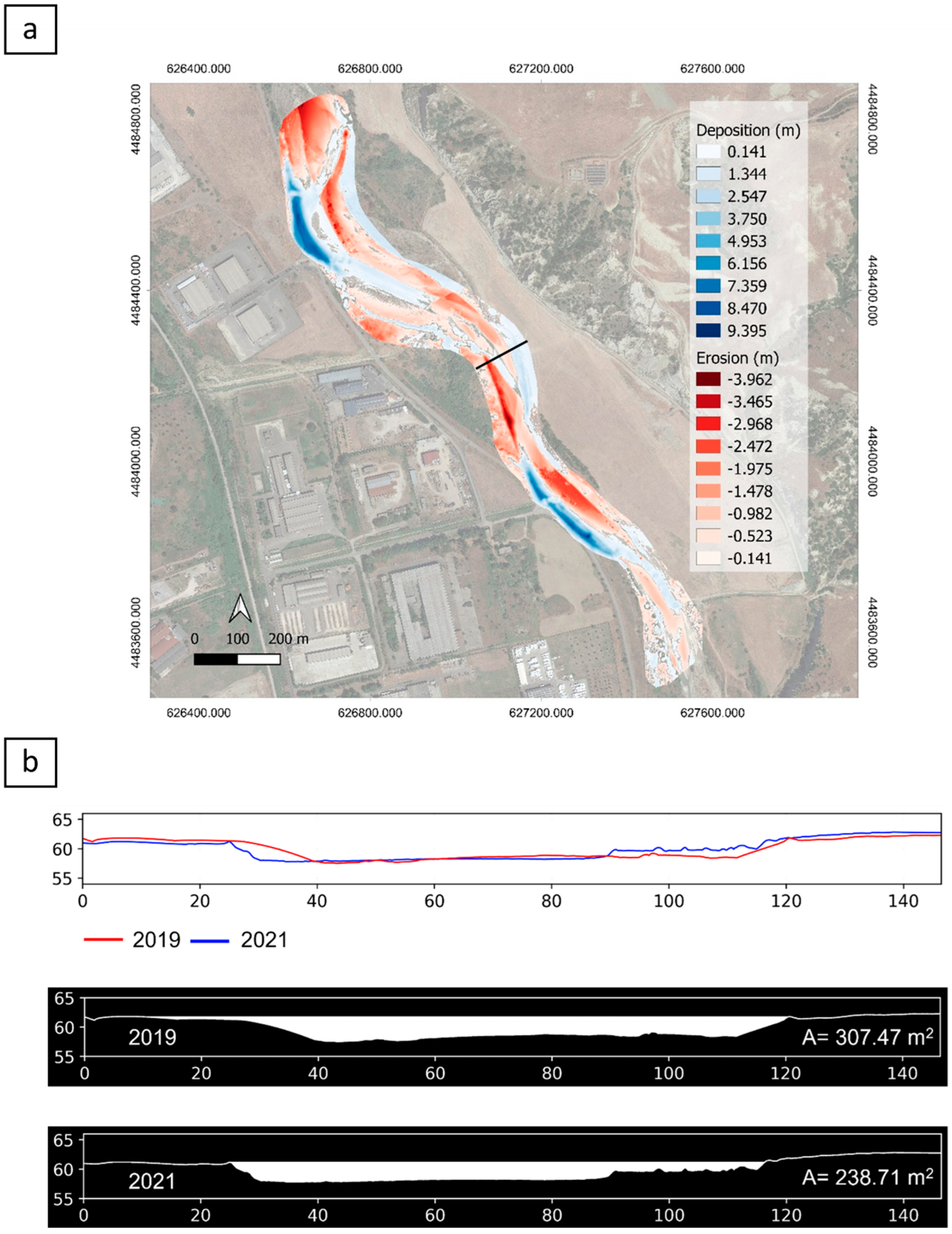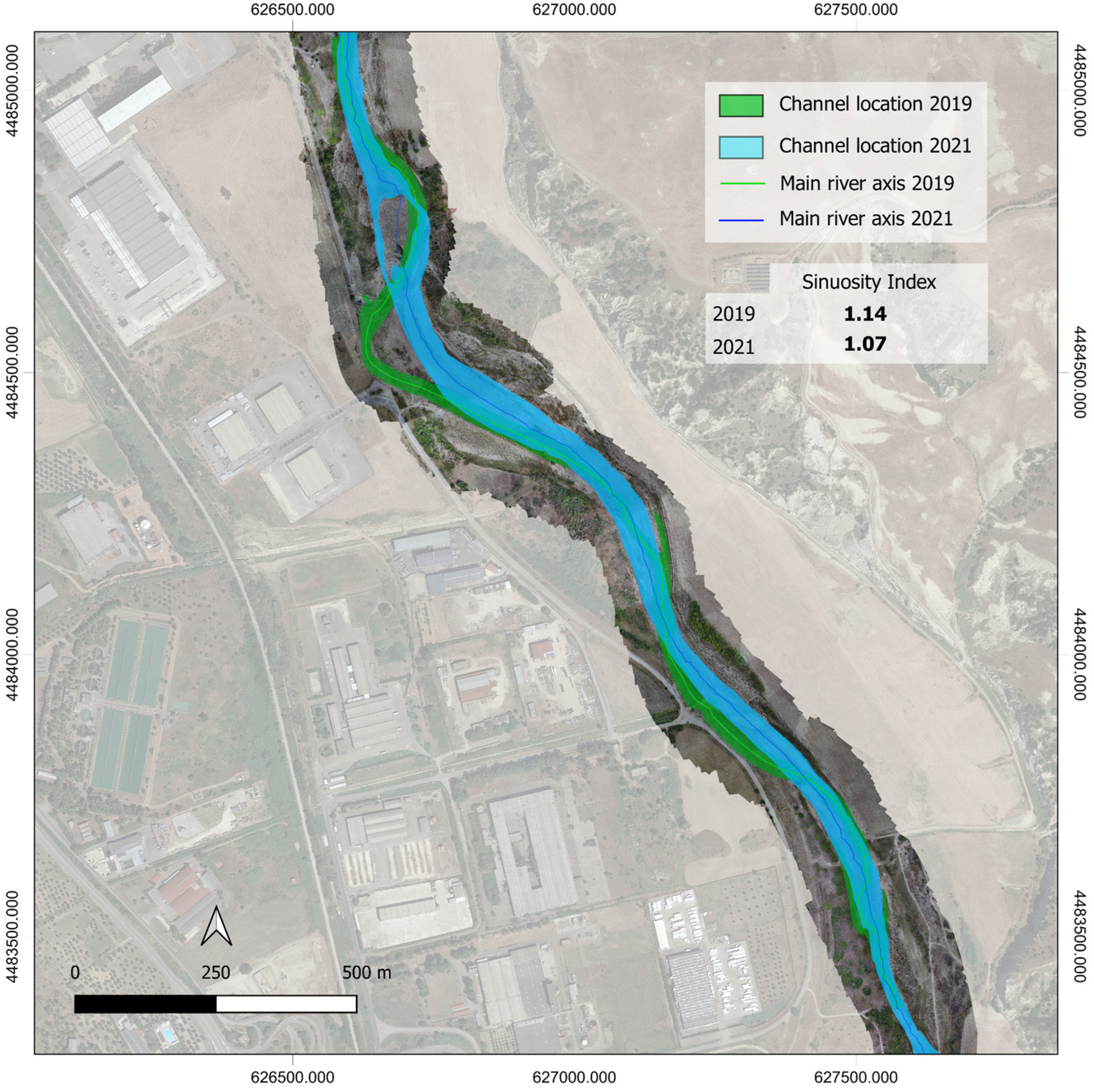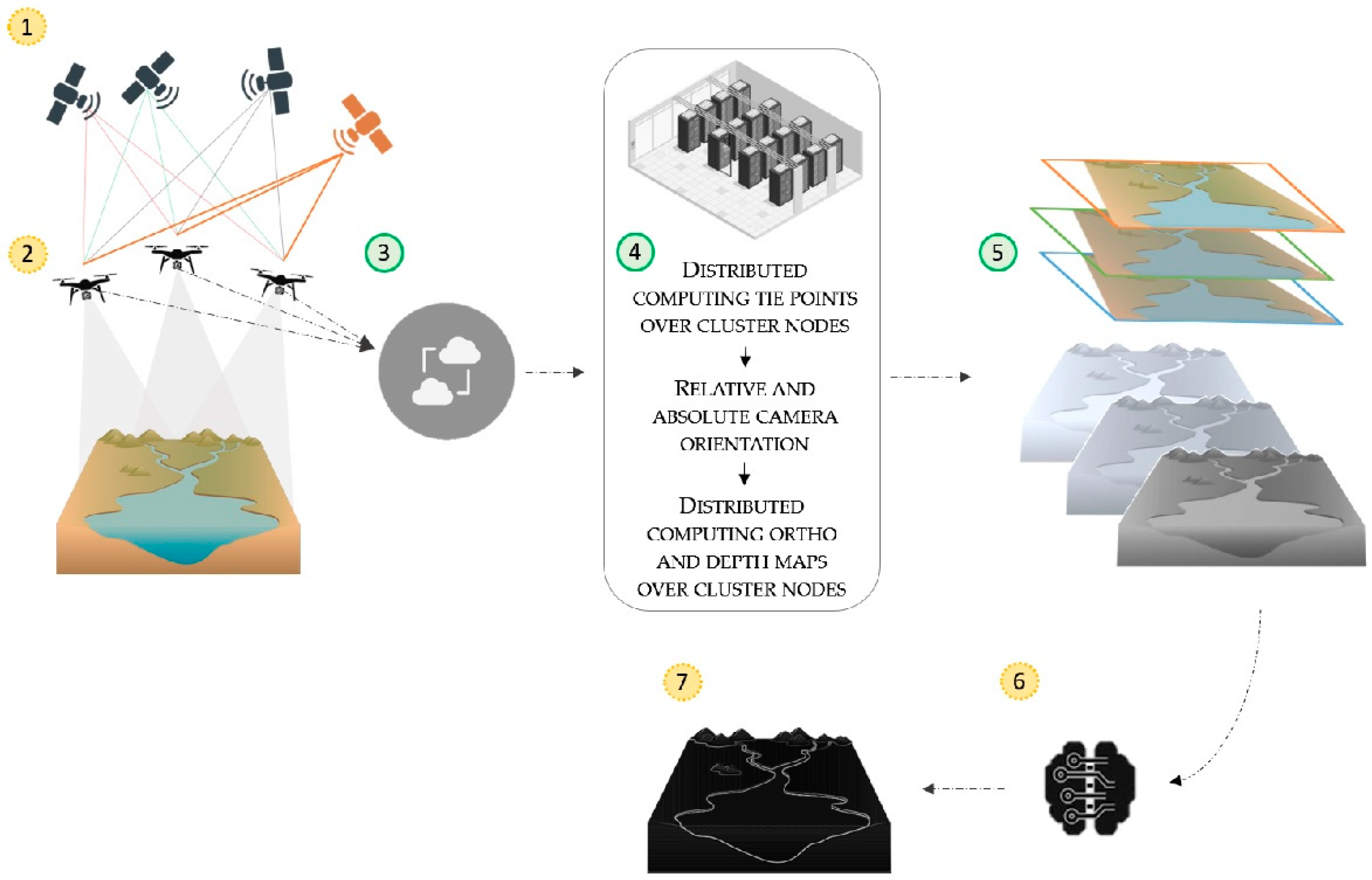New Perspectives of Earth Surface Remote Detection for Hydro-Geomorphological Monitoring of Rivers
Abstract
:1. Introduction
2. Methods
2.1. ARDAS Description
- Remote detection of the Earth’s surface through UAV systems. This surveying technique overcomes the intrinsic limitations of satellite- and airborne-based optical imagery and in situ traditional surveys. In fact, it ensures the acquisition of very-high-resolution spatial data with a high temporal frequency in the most dynamic environments (as the fluvial one), even by using a cheap consumer-grade digital camera [46]. These capabilities prove critical for identifying and monitoring active phenomena that drive topographic changes, ensuring, for example, detailed mapping of riverine landscapes, for flood and disaster relief [47,48].
- NRT processing of data acquired from UAVs in the cloud environment through a massive operational data-center that provides great computing power and storage capacity through cluster computers that automatically process large datasets of high-resolution UAV images by applying a parallel computing photogrammetric workflow. High computing and data storage resources are needed to perform the computing task so that the results can be obtained in reasonable time, a key aspect especially in emergency scenarios. Thus, the concept of NRT is intended as minimizing the processing time of UAV images, uploaded by the user to the cloud environment, by taking advantage of the nearly unlimited computational resources made available [49]. In fact, mapping wide areas of the Earth’s surface by using UAV-based photogrammetry (low-altitude flight and low range coverage) can result in thousands or ten-thousands of high-resolution images (gigabyte or even terabyte), which need this type of solution to avoid limits in the photogrammetric processing [50].
- Data processing through the application of a photogrammetric workflow based on SfM techniques [51]. The sequential acquisition of images at different angles and the following overlap define the 3D position of the image descriptors in order to determine the three-dimensional structure of the surface [52]. SfM processing leads to the generation of several outputs (point cloud, ortho-photomosaic, DEM, textured mesh) through the achievement of a sequence of steps: (i) detection of key features and tie points of the images by applying the scale-invariant feature transform (SIFT) algorithm [53]; (ii) estimation of the calibration parameters and camera position and orientation by applying bundle adjustment [54]; (iii) dense correlation by applying a clustering view for the multi-view stereo algorithm (CVMVS) [55]; and (iv) orthorectification. The processing is executed through a parallel open-source photogrammetric workflow exploiting the nodes that compose a computing cluster to distribute the most computationally demanding steps.
- Generation and post-processing of VHR products: ortho-photomosaic and DEM (minimum achievable spatial resolution of 1 cm) obtained by multi-temporal UAV surveys. The outputs are used to monitor river evolution by applying methods of hydro-geomorphological analysis, such as change detection and parameter extraction. In fact, the application of ARDAS over time allows comparing output by computing the DEM of Difference (DoD) and hydro-geomorphological parameters. ARDAS is structured to partly automate data processing in order to avail in a very short time the necessary products for the assessment of river conditions and the connected risks.
2.2. ARDAS Application
3. Results
4. Discussion
- High-accuracy positioning of the UAV fleet by the European navigation satellite systems of Galileo and EGNOS (Panels 1 and 2 in Figure 7). Each UAV belonging to the fleet would integrate GNSS receivers (Galileo and GPS; [58]) so that it is able to get signals from the highest number of dual-frequency satellites, i.e., two GNSS signals at different frequencies from a satellite, providing increased reliability in challenging environments. In addition, leveraging the EGNOS system, a real-time augmentation of the original GNSS signals received from each UAV is applied with differential correction from stations developed across Europe. This very high accurate positioning system improves the accuracy, reliability, safety, and continuity of the correct GNSS positioning information for each UAV, determining a favorable condition for Beyond Visual Line Of Sight (BVLOS) automatic flight missions of the fleet. The BVLOS operation modality of multiple UAVs is suitable to detect a large area of the Earth’s surface, such as the course of the river in a catchment. However, it requires the accurate positioning of each individual UAV in action in order to avoid multipath interference errors and to ensure the complete mapping of the area, even in poorly accessible conditions, such as mountainous and/or dense vegetated areas, buildings, and other potential obstacles. This remote sensing system makes the simultaneous photogrammetry flight missions of multiple UAVs highly accurate.
- A real-time data transmission system from each UAV to the cloud environment. Potential implementation of a connection network with data informatization that can ensure the real-time transfer of data acquired by each UAV into the cloud environment, by exploiting the potential of these tools to connect to the Internet and to generate and transmit data streams through the IoT (Internet of Things) paradigm. The real-time concept translates into optimizing the time of output generation by processing the data at the same moment of acquisition or at least within a very short subsequent time interval, with a continuous Input → Processing → Output chain.
- Application of automation algorithms for the extrapolation of hydro-geomorphological features and parameters from VHR products (Panels 6 and 7 in Figure 7). The algorithms would implement an analytical procedure that executes the river geomorphological characterization and change detection in a flexible mode. Depending on the scale and phase of the investigation, the workflow could apply (i) river segmentation by executing pixel-based classification through image-processing techniques; (ii) detection of potential morphological modifications by applying DoD with a continuous and automatic update of consecutive UAV surveys; (iii) individuation of critical sections along river reaches identified by the previous step and extraction of relative profiles from the DEM through the interpolation of elevation points; and (iv) measurement and examination of the hydrological and morphological variables that control the fluvial processes by trying to automatically compute components of the indices listed in Table 1 (for example, the confinement index could be computed by using vector lines of channel width and floodplain derived from the first (i) step). Although this proposed implementation could be a challenge, the automation of the procedure would reduce the investigation timing without limiting the spatial extension of the observation area.
5. Conclusions
- Generation of NRT VHR outputs, i.e., an ortho-photomosaic and DEM, is useful for multi-temporal hydro-geomorphological analysis.
- The very short time of data processing is crucial for risk assessment and management of monitoring and emergency activities.
- The main advantage of ARDAS is satisfying the need to rapidly access highly accurate information.
- The potential limits of ARDAS, such as detection of only some river reaches and the need to move manually from one sequence to another in the system, would be overcome in future development of the system.
Author Contributions
Funding
Data Availability Statement
Acknowledgments
Conflicts of Interest
References
- Baker, V.R. Geomorphological Understanding of Floods. In Geomorphology and Natural Hazards; Elsevier: Amsterdam, The Netherlands, 1994; pp. 139–156. ISBN 978-0-444-82012-9. [Google Scholar]
- Howard, A.J. Managing Global Heritage in the Face of Future Climate Change: The Importance of Understanding Geological and Geomorphological Processes and Hazards. Int. J. Herit. Stud. 2013, 19, 632–658. [Google Scholar] [CrossRef]
- Zingaro, M. Advanced Analysis and Integration of Remote Sensing and in Situ Data for Flood Monitoring. Rendiconti Online Della Soc. Geol. Ital. 2021, 54, 41–47. [Google Scholar] [CrossRef]
- Merz, B.; Aerts, J.; Arnbjerg-Nielsen, K.; Baldi, M.; Becker, A.; Bichet, A.; Blöschl, G.; Bouwer, L.M.; Brauer, A.; Cioffi, F.; et al. Floods and Climate: Emerging Perspectives for Flood Risk Assessment and Management. Nat. Hazards Earth Syst. Sci. 2014, 14, 1921–1942. [Google Scholar] [CrossRef] [Green Version]
- Wohl, E.E. Rivers in the Landscape; John Wiley & Sons Inc.: Hoboken, NJ, USA, 2014; ISBN 978-1-118-41483-5. [Google Scholar]
- Rinaldi, M.; Amponsah, W.; Benvenuti, M.; Borga, M.; Comiti, F.; Lucía, A.; Marchi, L.; Nardi, L.; Righini, M.; Surian, N. An Integrated Approach for Investigating Geomorphic Response to Extreme Events: Methodological Framework and Application to the October 2011 Flood in the Magra River Catchment, Italy: Integrated Approach for Investigating Geomorphic Response to Floods. Earth Surf. Process. Landf. 2016, 41, 835–846. [Google Scholar] [CrossRef]
- Righini, M.; Surian, N. Remote Sensing as a Tool for Analysing Channel Dynamics and Geomorphic Effects of Floods. In Flood Monitoring through Remote Sensing; Springer International Publishing: Berlin/Heidelberg, Germany, 2018; pp. 27–59. [Google Scholar]
- de Musso, N.M.; Capolongo, D.; Caldara, M.; Surian, N.; Pennetta, L. Channel Changes and Controlling Factors over the Past 150 Years in the Basento River (Southern Italy). Water 2020, 12, 307. [Google Scholar] [CrossRef] [Green Version]
- Buraas, E.M.; Renshaw, C.E.; Magilligan, F.J.; Dade, W.B. Impact of Reach Geometry on Stream Channel Sensitivity to Extreme Floods: Impact of Reach Geometry on Stream Channel Sensitivity to Floods. Earth Surf. Process. Landf. 2014, 39, 1778–1789. [Google Scholar] [CrossRef]
- Rinaldi, M.; Belletti, B.; Bussettini, M.; Comiti, F.; Golfieri, B.; Lastoria, B.; Marchese, E.; Nardi, L.; Surian, N. New Tools for the Hydromorphological Assessment and Monitoring of European Streams. J. Environ. Manage. 2017, 202, 363–378. [Google Scholar] [CrossRef] [PubMed]
- Zingaro, M.; Refice, A.; D’Addabbo, A.; Hostache, R.; Chini, M.; Capolongo, D. Experimental Application of Sediment Flow Connectivity Index (SCI) in Flood Monitoring. Water 2020, 12, 1857. [Google Scholar] [CrossRef]
- La Salandra, M.; Roseto, R.; Mele, D.; Dellino, P.; Capolongo, D. Probabilistic Hydro-Geomorphological Hazard Assessment Based on UAV-Derived High-Resolution Topographic Data: The Case of Basento River (Southern Italy). Sci. Total Environ. 2022, 842, 156736. [Google Scholar] [CrossRef]
- Wang, J.; Shi, B.; Yuan, Q.; Zhao, E.; Bai, T.; Yang, S. Hydro-Geomorphological Regime of the Lower Yellow River and Delta in Response to the Water–Sediment Regulation Scheme: Process, Mechanism and Implication. CATENA 2022, 219, 106646. [Google Scholar] [CrossRef]
- Pierdicca, N.; Pulvirenti, L.; Chini, M.; Boni, G.; Squicciarino, G.; Candela, L. Flood Mapping by SAR: Possible Approaches to Mitigate Errors Due to Ambiguous Radar Signatures. In Proceedings of the 2014 IEEE Geoscience and Remote Sensing Symposium, Quebec City, QC, Canada, 13–18 July 2014; pp. 3850–3853. [Google Scholar]
- Refice, A.; D’Addabbo, A.; Capolongo, D. Methods, Techniques and Sensors for Precision Flood Monitoring through Remote Sensing. In Flood Monitoring through Remote Sensing; Springer International Publishing: Berlin/Heidelberg, Germany, 2018; pp. 1–25. [Google Scholar]
- Schumann, G.; Bates, P.D.; Horritt, M.S.; Matgen, P.; Pappenberger, F. Progress in Integration of Remote Sensing–Derived Flood Extent and Stage Data and Hydraulic Models. Rev. Geophys. 2009, 47, RG4001. [Google Scholar] [CrossRef]
- Grimaldi, S.; Li, Y.; Pauwels, V.R.N.; Walker, J.P. Remote Sensing-Derived Water Extent and Level to Constrain Hydraulic Flood Forecasting Models: Opportunities and Challenges. Surv. Geophys. 2016, 37, 977–1034. [Google Scholar] [CrossRef]
- Ahamed, A.; Bolten, J.; Doyle, C.; Fayne, J. Near Real-Time Flood Monitoring and Impact Assessment Systems. In Remote Sensing of Hydrological Extremes; Lakshmi, V., Ed.; Springer Remote Sensing/Photogrammetry; Springer International Publishing: Cham, Switzerland, 2017; pp. 105–118. ISBN 978-3-319-43743-9. [Google Scholar]
- Zingaro, M.; La Salandra, M.; Colacicco, R.; Roseto, R.; Petio, P.; Capolongo, D. Suitability Assessment of Global, Continental and National Digital Elevation Models for Geomorphological Analyses in Italy. Trans. GIS 2021, 25, 2283–2308. [Google Scholar] [CrossRef]
- Krapesch, G.; Hauer, C.; Habersack, H. Scale Orientated Analysis of River Width Changes Due to Extreme Flood Hazards. Nat. Hazards Earth Syst. Sci. 2011, 11, 2137–2147. [Google Scholar] [CrossRef] [Green Version]
- Rigon, E.; Moretto, J.; Delai, F.; Picco, L.; Ravazzolo, D.; Rainato, R.; Lenzi, M.A. Application of the New Morphological Quality Index in the Cordevole River (BL, Italy). J. Agric. Eng. 2013, 44. [Google Scholar] [CrossRef]
- Bryant, R.G.; Gilvear, D.J. Quantifying Geomorphic and Riparian Land Cover Changes Either Side of a Large Flood Event Using Airborne Remote Sensing: River Tay, Scotland. Geomorphology 1999, 29, 307–321. [Google Scholar] [CrossRef]
- Kumar, R.; Kamal, V.; Kumar Singh, R. Geomorphic Effects of 2011 Floods on Channel Belt Parameters of Rapti River: A Remote Sensing and GIS Approach. Corona J. Sci. Technol. 2013, 4–12. [Google Scholar]
- Surian, N.; Righini, M.; Lucía, A.; Nardi, L.; Amponsah, W.; Benvenuti, M.; Borga, M.; Cavalli, M.; Comiti, F.; Marchi, L.; et al. Channel Response to Extreme Floods: Insights on Controlling Factors from Six Mountain Rivers in Northern Apennines, Italy. Geomorphology 2016, 272, 78–91. [Google Scholar] [CrossRef]
- Hemmelder, S.; Marra, W.; Markies, H.; De Jong, S.M. Monitoring River Morphology & Bank Erosion Using UAV Imagery—A Case Study of the River Buëch, Hautes-Alpes, France. Int. J. Appl. Earth Obs. Geoinf. 2018, 73, 428–437. [Google Scholar] [CrossRef]
- Brivio, P.; Colombo, R.; Maggi, M.; Tomasoni, R. Integration of Remote Sensing Data and GIS for Accurate Mapping of Flooded Areas. Int. J. Remote Sens. 2002, 23, 429–441. [Google Scholar] [CrossRef]
- de Musso, N.M.; Capolongo, D.; Refice, A.; Lovergine, F.P.; D’Addabbo, A.; Pennetta, L. Spatial Evolution of the December 2013 Metaponto Plain (Basilicata, Italy) Flood Event Using Multi-Source and High-Resolution Remotely Sensed Data. J. Maps 2018, 14, 219–229. [Google Scholar] [CrossRef]
- Refice, A.; Zingaro, M.; D’Addabbo, A.; Chini, M. Integrating C- and L-Band SAR Imagery for Detailed Flood Monitoring of Remote Vegetated Areas. Water 2020, 12, 2745. [Google Scholar] [CrossRef]
- Albertini, C.; Gioia, A.; Iacobellis, V.; Manfreda, S. Surface Water Detection and Flood Mapping Using Optical Remote Sensing and Water-Related Spectral Indices; Copernicus Meetings: Göttingen, Germany, 2022. [Google Scholar]
- Manfreda, S.; Sole, A.; Di Leo, M. Detection of Flood-Prone Areas Using Digital Elevation Models. J. Hydrol. Eng. 2011, 16, 781–790. [Google Scholar] [CrossRef]
- Alfieri, L.; Salamon, P.; Bianchi, A.; Neal, J.; Bates, P.; Feyen, L. Advances in Pan-European Flood Hazard Mapping. Hydrol. Process. 2014, 28, 4067–4077. [Google Scholar] [CrossRef]
- Revilla-Romero, B.; Wanders, N.; Burek, P.; Salamon, P.; de Roo, A. Integrating Remotely Sensed Surface Water Extent into Continental Scale Hydrology. J. Hydrol. 2016, 543, 659–670. [Google Scholar] [CrossRef] [PubMed]
- Hostache, R.; Chini, M.; Giustarini, L.; Neal, J.; Kavetski, D.; Wood, M.; Corato, G.; Pelich, R.; Matgen, P. Near-Real-Time Assimilation of SAR-Derived Flood Maps for Improving Flood Forecasts. Water Resour. Res. 2018, 54, 5516–5535. [Google Scholar] [CrossRef]
- Manfreda, S. Use of Unmanned Aerial Systems for Hydrological Monitoring; Copernicus Meetings: Göttingen, Germany, 2020. [Google Scholar]
- Di Mauro, C.; Hostache, R.; Matgen, P.; Pelich, R.; Chini, M.; van Leeuwen, P.J.; Nichols, N.; Blöschl, G. A Tempered Particle Filter to Enhance the Assimilation of SAR-Derived Flood Extent Maps into Flood Forecasting Models. Water Resour. Res. 2022, 58, e2022WR031940. [Google Scholar] [CrossRef]
- Langat, P.K.; Kumar, L.; Koech, R. Monitoring River Channel Dynamics Using Remote Sensing and GIS Techniques. Geomorphology 2019, 325, 92–102. [Google Scholar] [CrossRef]
- Nath, R.K.; Deb, S.K. Water-Body Area Extraction from High Resolution Satellite Images-An Introduction, Review, and Comparison. Int. J. Image Processing (IJIP) 2010, 3, 265–384. [Google Scholar]
- Sghaier, M.O.; Foucher, S.; Lepage, R.; Dahmane, M. Combination of Texture and Shape Analysis for a Rapid Rivers Extraction from High Resolution SAR Images. In Proceedings of the 2016 IEEE International Geoscience and Remote Sensing Symposium (IGARSS), Beijing, China, 10–15 July 2016; IEEE: Manhattan, NY, USA, 2016. [Google Scholar] [CrossRef]
- Li, D.; Wang, G.; Qin, C.; Wu, B. River Extraction under Bankfull Discharge Conditions Based on Sentinel-2 Imagery and DEM Data. Remote Sens. 2021, 13, 2650. [Google Scholar] [CrossRef]
- Capolongo, D.; Refice, A.; Bocchiola, D.; D’Addabbo, A.; Vouvalidis, K.; Soncini, A.; Zingaro, M.; Bovenga, F.; Stamatopoulos, L. Coupling Multitemporal Remote Sensing with Geomorphology and Hydrological Modeling for Post Flood Recovery in the Strymonas Dammed River Basin (Greece). Sci. Total Environ. 2019, 651, 1958–1968. [Google Scholar] [CrossRef] [PubMed]
- Samela, C.; Troy, T.J.; Manfreda, S. Geomorphic Classifiers for Flood-Prone Areas Delineation for Data-Scarce Environments. Adv. Water Resour. 2017, 102, 13. [Google Scholar] [CrossRef]
- Totaro, V.; Peschechera, G.; Gioia, A.; Iacobellis, V.; Fratino, U. Comparison of Satellite and Geomorphic Indices for Flooded Areas Detection in a Mediterranean River Basin. In Proceedings of the Computational Science and Its Applications—ICCSA 2019; Misra, S., Gervasi, O., Murgante, B., Stankova, E., Korkhov, V., Torre, C., Rocha, A.M.A.C., Taniar, D., Apduhan, B.O., Tarantino, E., Eds.; Springer International Publishing: Cham, Switzerland, 2019; pp. 173–185. [Google Scholar]
- Matgen, P.; Giustarini, L.; Chini, M.; Hostache, R.; Wood, M.; Schlaffer, S. Creating a Water Depth Map from SAR Flood Extent and Topography Data. In Proceedings of the 2016 IEEE International Geoscience and Remote Sensing Symposium (IGARSS), Beijing, China, 10–15 July 2016; pp. 7635–7638. [Google Scholar]
- Wood, M.; Hostache, R.; Neal, J.; Wagener, T.; Giustarini, L.; Chini, M.; Corato, G.; Matgen, P.; Bates, P. Calibration of Channel Depth and Friction Parameters in the LISFLOOD-FP Hydraulic Model Using Medium-Resolution SAR Data and Identifiability Techniques. Hydrol. Earth Syst. Sci. 2016, 20, 4983–4997. [Google Scholar] [CrossRef] [Green Version]
- La Salandra, M.; Miniello, G.; Nicotri, S.; Italiano, A.; Donvito, G.; Maggi, G.; Dellino, P.; Capolongo, D. Generating UAV High-Resolution Topographic Data within a FOSS Photogrammetric Workflow Using High-Performance Computing Clusters. Int. J. Appl. Earth Obs. Geoinf. 2021, 105, 102600. [Google Scholar] [CrossRef]
- Westoby, M.J.; Brasington, J.; Glasser, N.F.; Hambrey, M.J.; Reynolds, J.M. ‘Structure-from-Motion’ Photogrammetry: A Low-Cost, Effective Tool for Geoscience Applications. Geomorphology 2012, 179, 300–314. [Google Scholar] [CrossRef] [Green Version]
- Tamminga, A.D.; Eaton, B.C.; Hugenholtz, C.H. UAS-Based Remote Sensing of Fluvial Change Following an Extreme Flood Event: UAS REMOTE SENSING OF FLOOD EFFECTS. Earth Surf. Process. Landf. 2015, 40, 1464–1476. [Google Scholar] [CrossRef]
- Karamuz, E.; Romanowicz, R.J.; Doroszkiewicz, J. The Use of Unmanned Aerial Vehicles in Flood Hazard Assessment. J. Flood Risk Manag. 2020, 13, e12622. [Google Scholar] [CrossRef]
- Lee, J.; Wang, J.; Crandall, D.; Sabanovic, S.; Fox, G. Real-Time, Cloud-Based Object Detection for Unmanned Aerial Vehicles. In Proceedings of the 2017 First IEEE International Conference on Robotic Computing (IRC), Taichung, Taiwan, 10–12 April 2017; pp. 36–43. [Google Scholar]
- la Salandra, M.; Capolongo, D.; Pennella, V.; Nicotri, S.; Donvito, G. Application of Uav System and Sfm Techniques to Develop High-Resolution Terrain Models. In River Flow; CRC Press: Boca Raton, FL, USA, 2020; pp. 855–861. [Google Scholar]
- Eltner, A.; Sofia, G. Structure from Motion Photogrammetric Technique. In Developments in Earth Surface Processes; Elsevier: Amsterdam, The Netherlands, 2020; Volume 23, pp. 1–24. ISBN 978-0-444-64177-9. [Google Scholar]
- Snavely, N.; Seitz, S.M.; Szeliski, R. Modeling the World from Internet Photo Collections. Int. J. Comput. Vis. 2008, 80, 189–210. [Google Scholar] [CrossRef] [Green Version]
- Lowe, D.G. Distinctive Image Features from Scale-Invariant Keypoints. Int. J. Comput. Vis. 2004, 60, 91–110. [Google Scholar] [CrossRef]
- Triggs, B.; McLauchlan, P.F.; Hartley, R.I.; Fitzgibbon, A.W. Bundle Adjustment—A Modern Synthesis. In Vision Algorithms: Theory and Practice; Triggs, B., Zisserman, A., Szeliski, R., Eds.; Lecture Notes in Computer Science; Springer: Berlin/Heidelberg, Germany, 2000; Volume 1883, pp. 298–372. ISBN 978-3-540-67973-8. [Google Scholar]
- Furukawa, Y.; Curless, B.; Seitz, S.M.; Szeliski, R. Towards Internet-Scale Multi-View Stereo. In Proceedings of the 2010 IEEE Computer Society Conference on Computer Vision and Pattern Recognition, San Francisco, CA, USA, 13–18 June 2010; pp. 1434–1441. [Google Scholar]
- Belletti, B.; Rinaldi, M.; Buijse, A.D.; Gurnell, A.M.; Mosselman, E. A Review of Assessment Methods for River Hydromorphology. Environ. Earth Sci. 2015, 73, 2079–2100. [Google Scholar] [CrossRef]
- Gurnell, A.M.; Rinaldi, M.; Belletti, B.; Bizzi, S.; Blamauer, B.; Braca, G.; Buijse, A.D.; Bussettini, M.; Camenen, B.; Comiti, F.; et al. A Multi-Scale Hierarchical Framework for Developing Understanding of River Behaviour to Support River Management. Aquat. Sci. 2016, 78, 1–16. [Google Scholar] [CrossRef]
- Hein, G.W. From GPS and GLONASS via EGNOS to Galileo—Positioning and Navigation in the Third Millennium. GPS Solut. 2000, 3, 39–47. [Google Scholar] [CrossRef]
- OECD. OECD Handbook on Measuring the Space Economy; OECD: Paris, France, 2012; ISBN 978-92-64-12180-5. [Google Scholar]







| HYDRO-GEOMORPHOLOGICAL PARAMETERS | REMOTE DETECTION TECHNIQUES | REMOTE SENSING DATA | ||
|---|---|---|---|---|
| Definition | Components | Indirect Modality | Direct Modality | |
| Confinement Degree * |
| Channel boundary digitalization and measurement | Channel boundary extraction (spatial filtering, segmentation, pattern recognition) | DEM, satellite (O, S), aerial and UAV imagery |
| Confinement Index * |
| Channel and floodplain boundary digitalization and measurement | Channel boundary extraction: channel area/reach length from river axis (average width) | DEM, satellite (O, S), aerial and UAV imagery |
| Planimetric Channel Index * (sinuosity, anabranching, etc.) |
| Channel boundary digitalization and measurement | Channel boundary extraction | Satellite (O, S), aerial and UAV imagery |
| Discontinuity of riverbed slope * |
| - | Longitudinal profile extraction from InSAR and LiDAR derived DEM | DEM |
| Hydrological Discontinuity *,† |
| Tributaries detection | - | VHR satellite (O), aerial and UAV imagery, DEM |
| Artificiality (human-induced elements)† |
| Elements detection | - | VHR satellite (O), aerial and UAV imagery |
| Sediment Connectivity Index† |
| - | Slope from InSAR-LiDAR derived DEM; Land cover recognition (supervised algorithms); Surface roughness detection through the measurement of Haralik features | DEM, satellite (O, S), aerial and UAV imagery |
| Section Variability† |
| Elements detection | - | VHR satellite (O), aerial and UAV imagery |
| Banks Erodibility† |
| Only for banks retreat: multi-temporal analysis of images | Only for banks retreat: measurement of the shift derived from the multi-temporal comparison of channel | VHR satellite (O, S), aerial and UAV imagery |
| Presence of Large Wood Material† |
| Large wood detection | - | VHR satellite (O), aerial and UAV imagery |
| Width and Extent of Vegetation Band *,† |
| Vegetation band detection (mapping) | Vegetation band extraction (segmentation and pattern recognition; NDVI index and other ones; InSAR and PolSAR) | Satellite (O, S), aerial and UAV imagery |
| Slopes Instability† |
| Only for the landslides: slopes and channel observations | Only for the landslides: multi-temporal InSAR (PSI) | Satellite (O, S), aerial and UAV imagery |
| ARDAS | CPP | ||
|---|---|---|---|
| RMSE (m) | X | 0.86 | 0.92 |
| Y | 1.11 | 0.96 | |
| Z | 1.30 | 1.57 | |
| TIME (min) | 900 | 2400 | |
Publisher’s Note: MDPI stays neutral with regard to jurisdictional claims in published maps and institutional affiliations. |
© 2022 by the authors. Licensee MDPI, Basel, Switzerland. This article is an open access article distributed under the terms and conditions of the Creative Commons Attribution (CC BY) license (https://creativecommons.org/licenses/by/4.0/).
Share and Cite
Zingaro, M.; La Salandra, M.; Capolongo, D. New Perspectives of Earth Surface Remote Detection for Hydro-Geomorphological Monitoring of Rivers. Sustainability 2022, 14, 14093. https://doi.org/10.3390/su142114093
Zingaro M, La Salandra M, Capolongo D. New Perspectives of Earth Surface Remote Detection for Hydro-Geomorphological Monitoring of Rivers. Sustainability. 2022; 14(21):14093. https://doi.org/10.3390/su142114093
Chicago/Turabian StyleZingaro, Marina, Marco La Salandra, and Domenico Capolongo. 2022. "New Perspectives of Earth Surface Remote Detection for Hydro-Geomorphological Monitoring of Rivers" Sustainability 14, no. 21: 14093. https://doi.org/10.3390/su142114093
APA StyleZingaro, M., La Salandra, M., & Capolongo, D. (2022). New Perspectives of Earth Surface Remote Detection for Hydro-Geomorphological Monitoring of Rivers. Sustainability, 14(21), 14093. https://doi.org/10.3390/su142114093








